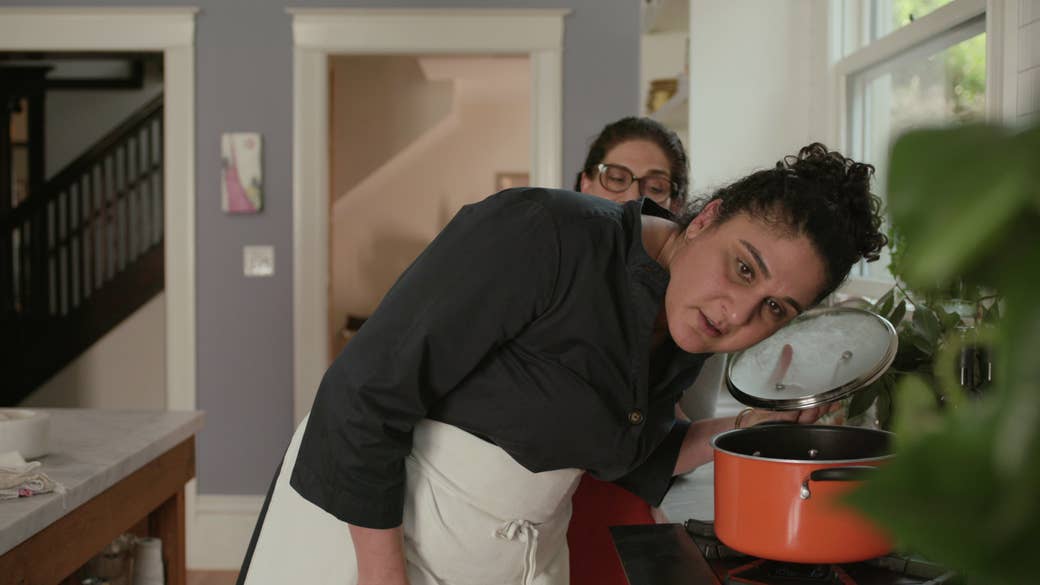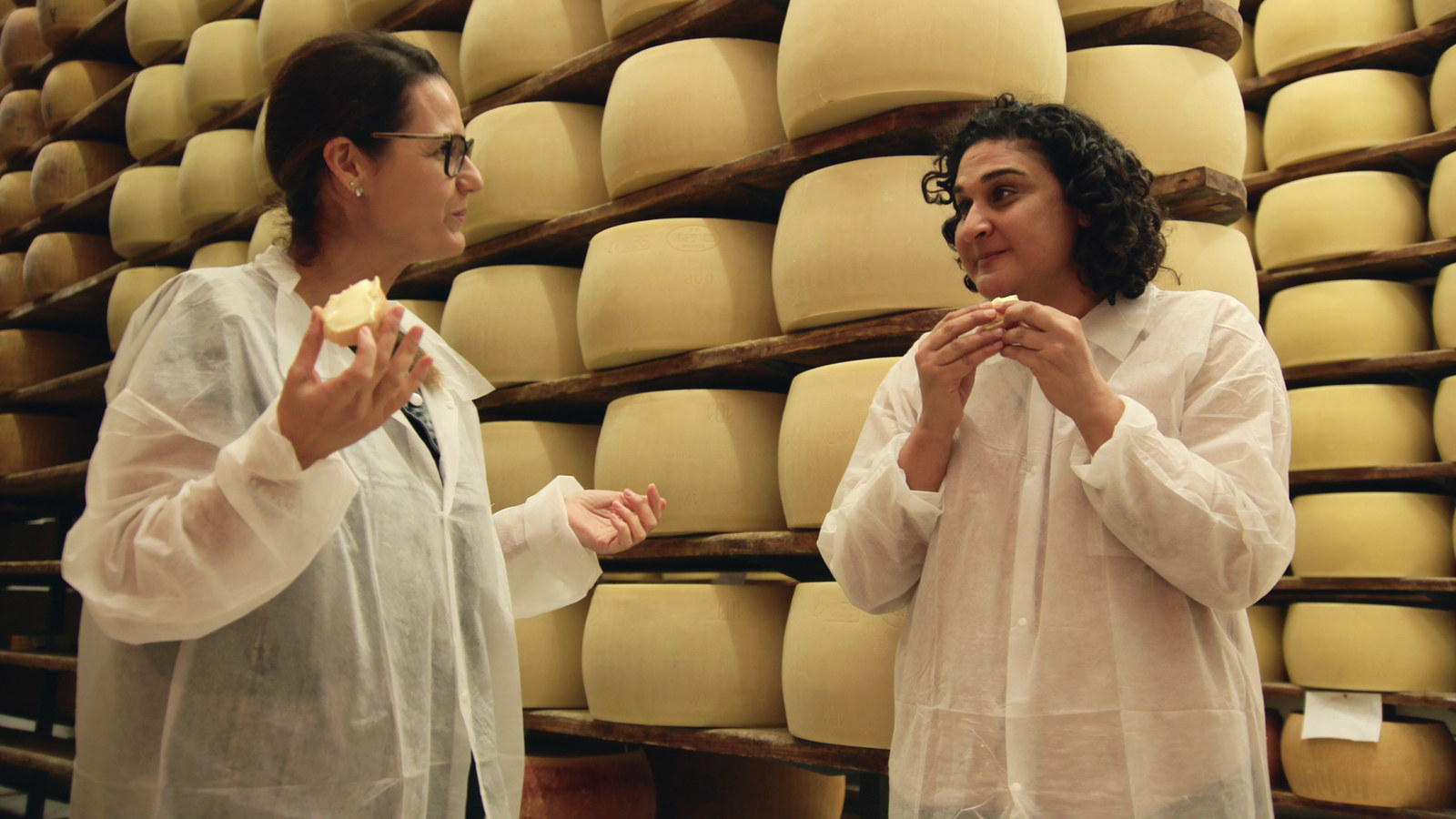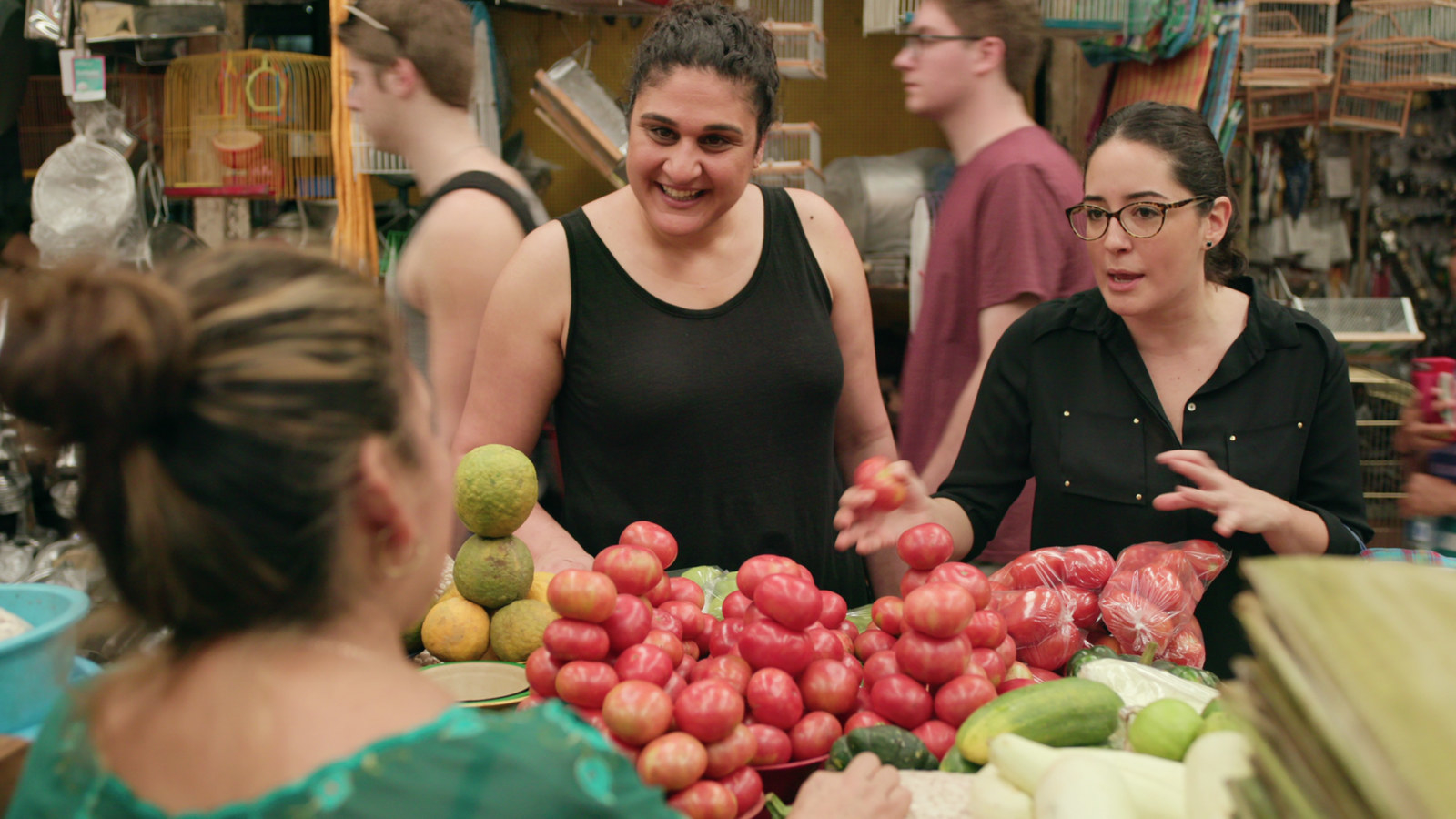
“I don’t make the soy sauce,” says Yasuo Yamamoto, aka “the soy sauce whisperer,” according to the onscreen caption in the first episode of Netflix’s Salt Fat Acid Heat.
“The microorganisms make it. I just create an environment where they can thrive. And I talk to them. My microorganisms work harder when someone is watching.”
Yamamoto leans down and listens to the vat bubbling and popping away. Just before this scene, he’d taken us through the fermentation process that produces soy sauce: vats of moromi — a mash of soybeans, wheat, salt, and water — working quietly. Yamamoto’s words, in Japanese, are underlined by a swelling string score that assists in transporting you to his factory, which is chockablock with barrels that are most likely older than anything viewers might own.
If you were to pause to take stock, you’d probably find your mouth is damp, anticipating the tang of the soy sauce (that you will sadly not be tasting). If you were to look in the mirror, you might find your pupils dilated. You might notice your heart rate has either picked up or relaxed considerably. Whatever your age, it would feel almost like a sudden and rapid onset of puberty — a body going through changes beyond your control.
This is the effect of Salt Fat Acid Heat, the new four-part documentary streaming on Netflix based on the eponymous book by Iranian American cook and writer Samin Nosrat. It is unconcerned with posturing, wholly respectful of its (noncelebrity) contributors, and intimate in a way that feels completely different in the “TV show built around a celebrity chef” genre that has thrived in recent years, aka men talking brashly about their ke-razy food adventures in extreme locations. Salt Fat Acid Heat is a break from that norm, and a formula that is bringing new fans and viewers to Nosrat’s infectiously dynamic style. It is also easily the most sensual TV experience of 2018.
Enter here, those who like to feel their television.
In the first episode, Lorenzo, an Italian hog farmer with a womanizing ancestor and the heart of a poet, says poetry is necessary in his line of work because he’s “constantly surrounded by the noise of breaking bones.” He then clacks a bone. Diego, the focaccia maker, calls his olive oil “lovable” and points out which three fingers do the trick before pressing them into the dough with a soft grunt. Elegant Ligurian Lidia, aka La Nonna, makes pesto in a pestle and mortar, and when she says, “It’s starting to give me satisfaction,” you can see she means it. The obvious care and delight these food mistresses and masters display is wildly sensual and sensuous. Enter here, those who like to feel their television.
I learned to cook from my own kitchen-confident parents. But television opened up my palate too: Growing up between Nigeria and England meant learning about regional foods from within my countries of origin and far, far beyond those borders. I turned to cooking show hosts like Funmi Adeoye, Delia Smith, Rick Stein, and the Two Fat Ladies — personalities that ran the gamut from warm and cuddly to stern, condescending, and insincere, and shows that varied in usefulness and ease. Chef Nosrat is doing something altogether different. You may think you’ve seen it all when it comes to cooking shows, but to watch Salt Acid Fat Heat is to immerse yourself in a way that feels total, unique, and exciting.
The makers of television long ago realized the power of food preparation on screen. Food is fascinating; tweaking a recipe is the original pop science programming many of us first experienced, and people love to watch other people prepare and talk about food. Food and cooking shows are as close as we can get to a universal currency for broadcast entertainment: accepted everywhere in the world, with only mild tweaks for local tastes needed.
To that end, Nosrat ends up traveling the world showcasing the four necessary elements her show is named for. For fat, we see her in Italy, at homesteads and olive harvests. She goes to the sea and the market in pursuit of salt in Japan. She travels through the citrus belt of Mexico, the Yucatán, for acid. And she ends her journey with heat, at home in Berkeley, California, making Iranian tahdig with her mother and going back to her formative professional home — the kitchen at Chez Panisse.

All the while, she exudes charm, which is nested in her genuineness, her eagerness to be a good guest, her passionate and game-for-anything personality, which sees her readily put all sorts of food in her mouth. Food means touch, and it is messy and real. And even when simple, this isn’t just any food — every dish cooked is the platonic ideal of that dish, and, of course, all that glorious food is set in the most glorious locations, with the most glorious of guests and guides. And speaking of guests, she has several. “I want to use [the show] to amplify the voices of — and also just present — people and stories that don’t typically make it to this level of exposure and to this kind of screen time,” Nosrat told the Atlantic in a recent interview.
In Japan, her chef friend Yuri cooks a celebratory tai meshi. In Mexico, she eats with Rodrigo, a salsa lover who convincingly says, “Salsa is my life.” She braises short ribs with New York Times Magazine journalist Jazmine Hughes. And there are so many other guests, a good number of them overlooked older women, not your usual suspects on a globe-trotting cooking show. There are grandmothers and mothers, young and old custodians of quickly disappearing food cultures. For example, when Nosrat washes her turkey with limes, I was transported back to my mother’s kitchen — I’d had no idea other people did that! One of the most moving and lovely sequences occurs in the “Acid” episode, when Nosrat travels to meet Doña Pascuala and Don Carlos, who tend to the extremely rare and precious Melipona bees. When Nosrat asks where they learned, Doña waves her hand and says simply, “It dates back to our ancestors.”
The shaping of palates is deeply culturally specific — what is “rich yet delicate” in one mouth become “slimy” in another (bless misunderstood okra, the light of my Nigeria-honed palate) — and Nosrat’s greatest gift is her enthusiasm, even for the foods that are unfamiliar or “strange.” She bows and thanks vendors, visibly impressed by their skill, their dedication, and the gift of their expertise. She speaks Spanish, Italian, and English, and when she doesn’t speak the language, as in Japan, her face is wide open and receptive as she nods and listens. We never see a translation happen, which feels correct and even more intimate. She is unafraid of joyful hyperbole and delicious turns of phrase: “This is so gorgeous, I’m having a heart attack right now,” she says as she tucks into a dish of tikin xic with chef Regina in the Yucatán. She describes the buttermilk in a roast chicken recipe as “delicious insurance.” She speaks of “eating [tacos] with my whole mouth.” Her grilled steak must have resistance and not be “mushy like the inside of my cheek.” None of these reactions feel canned or studied; she just seems to be preoccupied with making sure that she, and the food she cooks, is accessible.
And Nosrat’s enthusiasm is recorded not just in the words she says. In the “Acid” episode, she tastes a super-spicy salsa that makes her cry and laugh and cry some more before she takes a swig of beer and another bite. “You’re not afraid of the habanero. I can see it,” her companion tells her. (Crucially, this doesn’t seem like a “bad boy” display of testosterone and instead transmits a refreshing, cheerful immersion.) In the citrus market in the Yucatán, she sprinkles a little salt and chili on a passion fruit and knocks it back like a shot. The acidity she’s just imbibed shows up on her sublimely expressive face, and you make a sympathetic wince at home out of solidarity. When she tastes 24-month-aged vacche rosse Parmesan in Italy, her eyes well up from the textures and flavors. Watching her eat that cheese, do not be surprised if your own eyes fill with water: Nosrat has an exceptional capacity for transference.
Nosrat has an exceptional capacity for transference.
Just as important, the colors are ridiculous on this show. Nosrat’s cookware is bright, beautiful, and somehow familiar. In “Acid,” the recado (spice mix) is a fiery red, the robalo (a cousin of sea bass) is moon-white, and the charred vegetables create a texture rainbow of colors, especially when spread on waxy, deep green banana leaves. In “Heat,” she constructs a salad of cauliflower and Brussels sprouts and carrots and herbs that looks like a symphony on a plate. In “Salt,” the muted dark red of the miso wrapped around a boiled egg feels almost holy; in “Acid,” the peeled citrus fruits appear vulgar in their juiciness. Nosrat is never a distraction from the colors, though: The credits reveal that her comfortable and functional wardrobe comes from Toast, the Welsh mail-order company founded by archaeologists in 1997.
But there is also something very special going on with the sounds of Salt Fat Acid Heat — the sounds of this show pull up goosebumps. It’s all killer, no filler (or apparent Foley). Aluminum foil rustles, stoves click, fish scales creak, and salt is softly sprinkled (eat your heart out, Salt bae!). And that’s just inside the kitchen. Outside, birds chirp, cars swoosh by, and all around there are the conversations that occur in busy places, all coming together to create a 360-degree sensory trip in every moment. A solid tip to double your pleasure: Turn on the subtitles and read about the sounds you’re hearing. My current favorite closed-caption descriptions, both of which occur in “Heat,” are “[soft rattling, metallic clanking]” and “[squishy crunch]” when she’s carving a roast chicken.
Nosrat is not seeking cool as a “bad girl” of cooking — there are no leather jackets or exciting motorcycle road trips, and she’s not here to tell any non-English-speaking people how they’ve been doing it all wrong. She is already well-respected and -regarded by her industry and amateur home cooks alike, and she does not appear to be seeking kudos. What is left, then, is pure pleasure and excitement. And that is what we, the flushed viewers at home, respond to. Even with all other things being equal, we turn to food TV to educate and relax us, but in the roiling hellscape of 2018, Salt Fat Acid Heat produces feel-good endorphins that manifest as something close to peace.
Food’s primary function is fuel, but pleasure is a close second, and Samin Nosrat is having a great time teaching viewers about what makes food pleasurable. The final package is a curious mix of luxury and gravitas, swirled together with unfettered joy. It is wholly seductive. Salt Fat Acid Heat is a sensualist’s dream.
You should be watching, even if only to have a reason to light a cigarette and exhale lustily afterwards.

